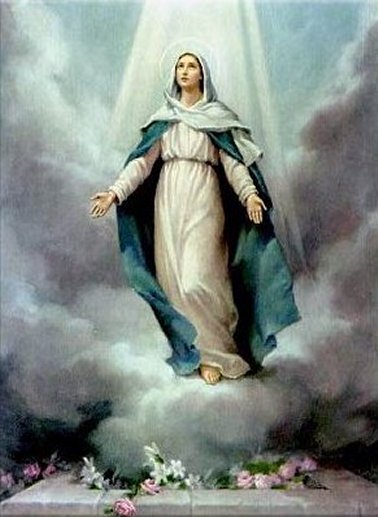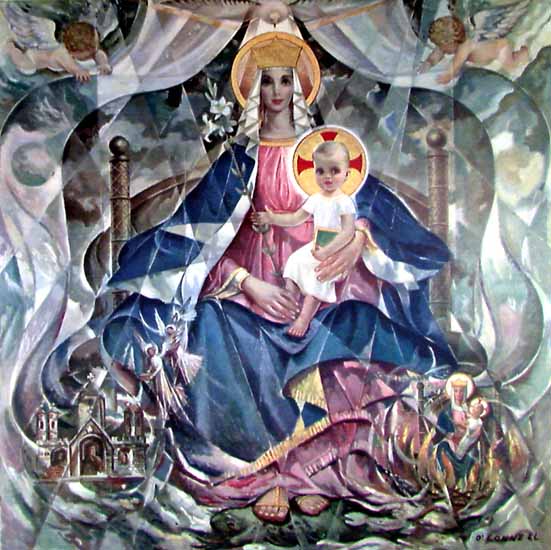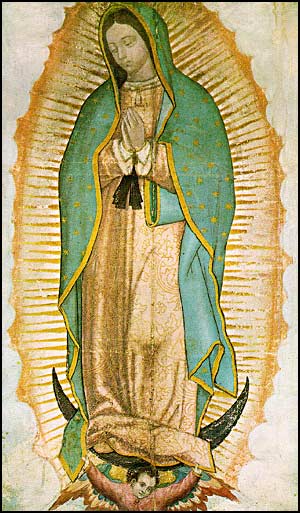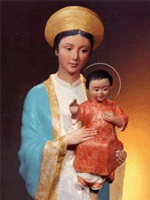Mary's Earlier Apparitions

January 1, Solemnity of the Blessed Virgin Mary, The Mother of God
Mary's appearances began in 40 AD, probably before she died, to James the Apostle in Saragossa, Spain. She has been appearing to others at irregular intervals throughout the two thousand years since she gave birth to Jesus. The characteristics of her apparitions have remained fairly consistent. She usually appears in a globe of pure white light, dressed in a long dress and head cover which vary in color depending on the content of her messages. Her feet are usually surrounded by a mist or cloud and she occassionally is seen holding her Son in her arms. A number of her appearances are preceded by unusual phenomena such as observations of lightning and thunder from a clear sky, apparitions of angelic beings or clouds of unusual shapes and religious significance such as a cross or a doorway as well as other inexplicable events.
The following is a brief overview of Mary's appearances throughout Christian history. It's meant to be representative of her apparitions and the events surrounding them but is not an all-inclusive listing:
Our Lady of the Pillar - Saragossa, Spain (ca. 40 AD).
After the Crucifixion, Ressurection and Ascension of Jesus, his Apostles began to spread the message he left throughout Israel and shortly thereafter, through the Roman Empire. One of these Apostles, James (the Greater), reportedly travelled as far west as Spain to the village of Saragossa in northeast Spain. While James was there, he became disheartened because of the failure of his mission. Tradition holds that while he was deep in prayer Jesus' Blessed Mother appeared to him and gave him a small wooden statue of herself and a column of jasper wood and instructed him to build a church in her honor: "This place is to be my house, and this image and column shall be the title and altar of the temple that you shall build." The jasper column and the wooden statue can still be seen on special occassions at a church that houses them.
About a year after the apparition James arranged to build a small chapel in Mary's honor, the first Church ever dedicated to the honor of the Virgin Mary. After James returned to Jerusalem, he was executed by Herod Agrippa in about 44 AD, the first apostle to be martyred for his faith. Several of his disciples took his body and returned it for final burial in Spain. The local queen, observing several of the miracles performed by James' disciples, converted to Christianity and permitted James' body to be buried in a local field. Eight centuries later, a cathedral in honor of St. James was erected after his gravesite was rediscovered by a local hermit. The hermit found the burial site after noticing an unusual star formation. The site for the cathedral was called Compostella (starry field) and it is a major pilgrimage site to this day.
Saint Mary Major - Rome, Italy (ca. 352 AD)
With much of the Roman empire converted to Christianity, a number of pious Romans began to dedicate their wealth to honoring Mary and the Apostles by building shrines and churches dedicated to them. One such nobleman, John of Rome, and his wife decided to honor Mary in whatever way they could. In early August, John and his wife both had an unusual dream where Mary appeared to them and asked them to have a church built on one of Rome's seven hills - the Esquiline. John decided to tell the Pope, Liberius, about his dream and when he did the Pope told him that he, too, had a similar dream. On August 5th, they both went to Esquiline hill which they found covered with snow in a contour matching the outline of a church. Construction on a church conforming to the outline left by the snow was started immediately. The Bascilica of Santa Maria Maggiore in Rome, one of the largest churches on earth, celebrates its birth to this day on August 5th.
Our Lady of Walsingham - Walsingham England (ca. 1061)

Mary's presence in England began with three visions received by Lady Richeldis de Faverches, a widow who lived in a manor in Walsingham. In these visions, Mary showed Lady de Faverches the house in Nazareth where the angel Gabriel told Mary she would give birth to the Son of the Most High. The Blessed Mother asked Lady de Faverches to build a replica of her house in Nazareth dedicated as a memorial to the Annunciation to Mary and the Incarnation of the Lord Jesus Christ. Mary promised: "Let all who are in any way distressed or in need seek me there in that small house that you maintain for me at Walsingham. To all that seek me there shall be given succor." In the Middle Ages, Walsingham became one of the greatest pilgrimage sites in all of Europe. A church was constructed around the house to protect it from the elements. Many English kings conducted pilgrimages to Walsingham. The last of these was Henry VIII, who made three pilgrimages to the site before breaking with the Catholic Church in 1534 and forming the Church of England. Henry ordered the destruction of all Catholic shrines and places of religious worship. The Walsingham church and house were destroyed in the rampage of destruction that occurred.
The statue of Mary that resided in the house was burned several years later. It was not until the 1920's that Walsingham' Holy House was rebuilt at the direction of Alfred Patten, an Anglican priest. The Slipper Chapel, named in honor of those who - in the Middle Ages - removed their shoes to walk barefoot to the Holy House, a small Catholic chapel located near the Holy House had managed to escape the destruction of the Reformation. This chapel became the Catholic Shrine of Our Lady in England. Both sites have become active pilgrimage sites once again.
Our Lady of the Rosary - Prouille, France (1208)
Domingo de Guzman was a Spanish preacher who went to southern France to oppose the Albegesian heresy which was spreading rapidly. In 1208, while he was praying at a chapel in Prouille, Mary appeared to him and gave him the Rosary and urged him to preach the Rosary to all people as a remedy against heresy and sin. The factual basis for this series of events is questionable. Nonetheless, Domingo (Dominic) founded an order of preaching friars who went on to halt the Albegesian heresy and establish monasteries all over the world. The order is commonly referred to as the Dominicans.
Our Lady of Mount Carmel - Aylesford, England (1251):
Mary's continuing influence on the development of Christianity in England becomes apparent again with her appearance to Simon Stock, who became a member of the religous order of Our Lady of Mount Carmel while on a pilgrimage to the Holy Land. In her appearance to Friar Stock, Mary entrusted him with the brown scapular (two pieces of brown woolen cloth, usually embroidered with an outline of Our Lady of Mount Carmel, and tied together by string and worn over the shoulders) : "My beloved son, receive this scapular for your Order. It is the special sign of a privilege, which I have obtained for you and for all God's children who honor me as Our Lady of Mount Carmel. Those who die devotedly clothed with this scapular shall be preserved from eternal fire. The brown scapular is a badge of salvation. The brown scapular is a shield in time of danger. The brown scapular ia a pledge of peace and special protection, until the end of time." After this apparition, Friar Stock went on to establish Carmelite communities near university towns in England, France and Italy. He became the Superior-General of his order several years after the apparition. Until very recently, the brown scapular was one of the most widely used religious symbols of personal dedication to the mission of Mary found in her last recorded words in the Bible (John 2:5).
The promotion and use of all types of Marian devotional symbols has declined dramatically since the 1960's.
The Black Madonna - Czestochowa, Poland (1382)
The Black Madonna is a painting of the Madonna and Christ Child which legend states was painted by St. Luke the Evangelist. St. Luke is believed to have used a tabletop from a table built by the carpenter Jesus. It was while Luke was painting Mary that she told him about the events in the life of Jesus that he eventually incorporated in his gospel. The painting shows up again in 326 AD when St. Helen located it in Jerusalem while on a pilgrimage there. She gave the painting to her son, Constantine, who had a shrine built in Constantinople to house it. In a critical battle with the Saracens, the portrait was displayed from the walls of the city and the Saracens were subsequently routed. The portrait was credited with saving the city. The painting was eventually owned by Charlemagne who subsequently presented it to Prince Leo of Ruthenia (northwest Hungary). It remained at the royal palace in Ruthenia until an invasion occurred in the eleventh century. The king prayed to Our Lady to aid his small army and as a result of his prayers a darkness descended on the enemy troops who, in their confusion, began attacking one another. Ruthenia was saved as a result of this intervention.
In the fourteenth century, it was transferred to the Mount of Light (Jasna Gora) in Poland in response to a request made in a dream of Prince Ladislaus of Opola. This legendary history becomes better documented with the painting's ownership by Prince Ladislaus. In 1382, invading Tartars attacked the Prince's fortress at Belz. In this attack one of the Tartar arrows hit the painting and lodged in the throat of the Madonna. The Prince, fearing that he and the famous painting might fall to the Tartars, fled in the night finally stopping in the town of Czestochowa, where the painting was installed in a small church. The Prince subsequently had a Pauline monastery and church built to ensure the painting's safety. In 1430, the Hussites overran the monastery and attempted to take the portrait. One of the looters twice struck the painting with his sword but before he could strike another blow he fell to the floor writhing in agony and died. Both the sword cuts and the arrow wound are still visible in the painting.
Later, in 1655, Poland was almost entirely overrun by the forces of Sweden's King Charles X. Only the area around the monastery remained unconquered. Somehow, the monks of the monastery succesfully defended the portrait against a forty day seige and eventually all of Poland was able to drive out the invaders. After this remarkable turn of events, the Lady of Czestochowa became the symbol of Polish national unity and was crowned Queen of Poland. The King of Poland placed the country under the protection of the Blessed Mother. A more recent legend surrounding the painting involves the threat of a Russian invasion. In 1920, the Russian army was seen massing on the banks of the Vistula river, threatening Warsaw, when an image of the Virgin was seen in the clouds over the city. The Russian troops withdrew on seeing the image. There have been reports for centuries of miraculous events such as spontaneous healings occuring to those who made a pilgrimage to the portrait. It is known as the 'Black Madonna" because of the soot residue that discolors the painting. The soot is the result of centuries of votive lights and candles burning in front of the painting. With the decline of communism in Poland, pilgrimages to the Black Madonna have increased dramatically.
Our Lady of Guadalupe - Guadalupe, Mexico (1531)

The opening of the New World brought with it both fortune-seekers and religous preachers desiring to convert the native populations to the Christian faith. One of the converts was a poor Aztec indian named Juan Diego. On one of his trips to the chapel, Juan was walking through the Tepayac hill country in central Mexico. Near Tepayac Hill he encountered a beautiful woman surrounded by a ball of light as bright as the sun. Speaking in his native tongue, the beautiful lady identified herself: "My dear little son, I love you. I desire you to know who I am. I am the ever-virgin Mary, Mother of the true God who gives life and maintains its existence. He created all things. He is in all places. He is Lord of Heaven and Earth. I desire a church in this place where your people may experience my compassion. All those who sincerely ask my help in their work and in their sorrows will know my Mother's Heart in this place. Here I will see their tears; I will console them and they will be at peace. So run now to Tenochtitlan and tell the Bishop all that you have seen and heard."
Juan, age 57, and who had never been to Tenochtitlan, nonetheless immediately responded to Mary's request. He went to the palace of the Bishop-elect Fray Juan de Zumarraga and requested to meet immediatly with the bishop. The bishop's servants, who were suspicious of the rural peasant, kept him waiting for hours. The bishop-elect told Juan that he would consider the request of the Lady and told him he could visit him again if he so desired. Juan was disappointed by the bishop's response and felt himself unworthy to persuade someone as important as a bishop. He returned to the hill where he had first met Mary and found her there waiting for him. Imploring her to send someone else, she responded: "My little son, there are many I could send. But you are the one I have chosen." She then told him to return the next day to the bishop and repeat the request. On Sunday, after again waiting for hours, Juan met with the bishop who, on re-hearing his story, asked him to ask the Lady to provide a sign as a proof of who she was. Juan dutifully returned to the hill and told Mary, who was again waiting for him there, of the bishop's request. Mary responded: "My little son, am I not your Mother? Do not fear.
The Bishop shall have his sign. Come back to this place tomorrow. Only peace, my little son." Unfortunately, Juan was not able to return to the hill the next day. His uncle had become mortally ill and Juan stayed with him to care for him. After two days, with his uncle near death, Juan left his side to find a priest. Juan had to pass Tepayac Hill to get to the priest. As he was passing, he found Mary waiting for him. She spoke: "Do not be distressed, my littlest son. Am I not here with you who am your Mother? Are you not under my shadow and protection? Your uncle will not die at this time. There is no reason for you to engage a priest, for his health is restored at this moment. He is quite well. Go to the top of the hill and cut the flowers that are growing there. Bring them then to me." While it was freezing on the hillside, Juan obeyed Mary's instructions and went to the top of the hill where he found a full bloom of Castilian roses. Removing his tilma, a poncho-like cape made of cactus fiber, he cut the roses and carried them back to Mary. She rearranged the roses and told him: "My little son, this is the sign I am sending to the Bishop. Tell him that with this sign I request his greatest efforts to complete the church I desire in this place. Show these flowers to no one else but the Bishop. You are my trusted ambassador. This time the Bishop will believe all you tell him." At the palace, Juan once again came before the bishop and several of his advisors. He told the bishop his story and opened the tilma letting the flowers fall out. But it wasn't the beautiful roses that caused the bishop and his advisors to fall to their knees; for there, on the tilma, was a picture of the Blessed Virgin Mary precisely as Juan had described her.
The next day, after showing the Tilma at the Cathedral, Juan took the bishop to the spot where he first met Mary. He then returned to his village where he met his uncle who was completely cured. His uncle told him he had met a young woman, surrounded by a soft light, who told him that she had just sent his nephew to Tenochtitlan with a picture of herself. She told his uncle: "Call me and call my image Santa Maria de Guadalupe". It's believed that the word Guadalupe was actually a Spanish mis-translation of the local Aztec dialect. The word that Mary probably used was Coatlallope which means "one who treads on snakes"! Within six years of this apparition, six million Aztecs had converted to Catholicism. The tilma shows Mary as the God-bearer - she is pregnant with her Divine Son. Since the time the tilma was first impressed with a picture of the Mother of God, it has been subject to a variety of environmental hazards including smoke from fires and candles, water from floods and torrential downpours and, in 1921, a bomb which was planted by anti-clerical forces on an altar under it. There was also a cast-iron cross next to the tilma and when the bomb exploded, the cross was twisted out of shape, the marble altar rail was heavily damaged and the tilma was...untouched! Indeed, no one was injured in the Church despite the damage that occurred to a large part of the altar structure. In 1977, the tilma was examined using infrared photography and digital enhancement techniques. Unlike any painting, the tilma shows no sketching or any sign of outline drawn to permit an artist to produce a painting. Further, the very method used to create the image is still unknown. The image is inexplicable in its longevity and method of production. It can be seen today in a large cathedral built to house up to ten thousand worshipers. It is, by far, the most popular religious pilgrimage site in the Western Hemisphere.
Our Lady of Lavang - La'Vang, Vietnam (1798)

During much of the 18th century, the nation of Vietnam was embattled in various struggles for power and domination. The northern regions of the kingdom fell under the authority of the lords of the Trinh family, while in the southern realm the Nguyen lords took power. As the eighteenth century drew toward its close, both of their rules were shaken and threatened by peasant uprisings and emerging rebel forces. The strongest among the many uprisings was led by the three brothers from Tay Son. In short order, they overthrew the Nguyen lords and defeated the Trinh lords to restore national unity for the first time since the decline of the Le dynasty. A Tay Son brother was enthroned to be King Quang Trung. In 1792 he passed away and left the throne to his son who became King Canh Thinh. Meanwhile, Nguyen Anh continued his insurgency in trying to reclaim his throne. Earlier in his run from the Tay Son rebels in 1777, he found refuge on Phu Quoc Island, where Monsignor Pierre Pigneau de Behaine of the Society of Foreign Missions directed a seminary for youths from neighboring countries. The bishop persuaded him to seek help from King Louis XVI of France. King Canh Thinh knew that Nguyen Anh received support from the French missionary and worried that the Vietnamese Catholics would also endorse his reign. He began to restrict the practice of Catholicism in the country.
On August 17, 1798, King Canh Thinh issued an anti-Catholic edict and an order to destroy all Catholic churches and seminaries. A most grievous persecution of Vietnamese Catholics and missionaries began and lasted until 1886. Even after Nguyen Anh succeeded in reclaiming his throne as King Gia Long (1802-1820), his successors, King Minh Mang (1820-1840), King Thieu Tri (1841-1847) and King Tu Duc (1847-1884), the last Nguyen emperor, continued the vehement campaign against Catholics, ordering punishments that ranged from branding their faces to death by various cruel methods for Vietnamese Catholics and missionary priests. It was amidst this great suffering that the Lady of Lavang came to the people of Vietnam. The name Lavang was believed to be originated in the name of the deep forest in the central region of Vietnam (now known as Quang Tri City) where there was an abundance of a kind of trees named La' Vang. It was also said that its name came from the Vietnamese meaning of the word "Crying Out" to denote the cries for help of people being persecuted. The first apparition of the Lady of Lavang was noted in 1798, when the persecution of Vietnamese Catholics began. Many Catholics from the nearby town of Quang Tri sought refuge in the deep forest of Lavang. A great number of these people suffered from the bitter cold weather, lurking wild beasts, jungle sickness and starvation. At night, they often gathered in small groups to say the rosary and to pray. Unexpectedly, one night they were visited by an apparition of a beautiful Lady in a long cape, holding a child in her arms, with two angels at her sides. The people recognized the Lady as Our Blessed Mother.
A Child's Prayer to the Immaculate Heart of Mary

0 Virgin Mary, My Mother.
I give to your Immaculate Heart, my body and my soul, my thoughts and my actions.
I want to be what you want me to be, and do just what you want me to do.
I am not afraid because you are always with me.
Help me to love your Son Jesus, with all my heart and above all things.
Take my hand in yours so I can always be with you.
Amen.